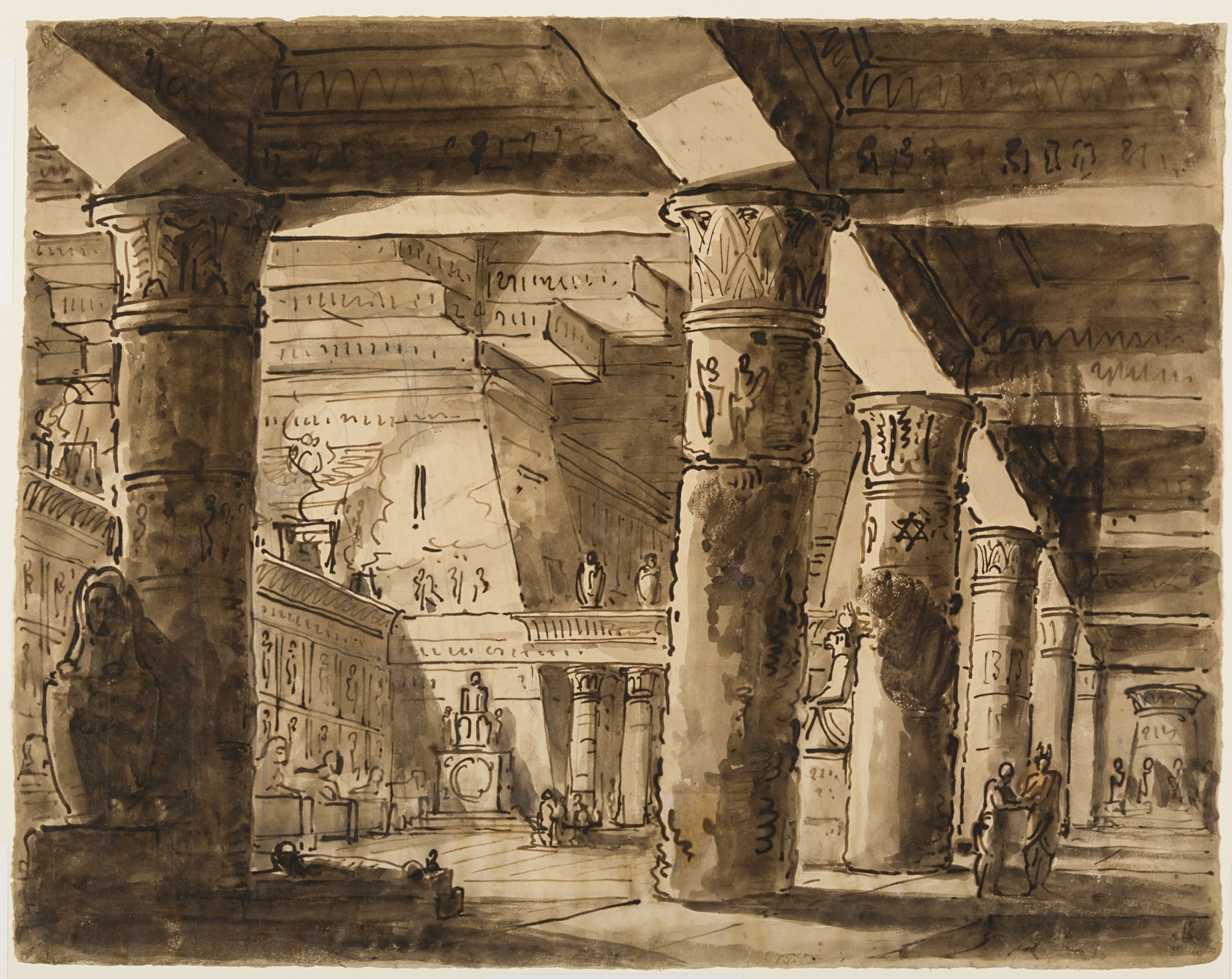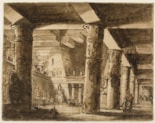Antonio BASOLI
(Castelguelfo 1744 - Bologna 1848)
The Interior of an Egyptian Temple
Sold
Pen and brown ink and brown wash, over an underdrawing in black chalk.
Inscribed 'Fatto all’improvviso dal Prof.e Ant.o Basoli / avendo prima fatto fare delle macchie sulla / carta ed essendo gli stato dato l’argomento / La sera dei 14 Marzo 1824 / in casa della Sig.ra Caterina / Lipparini la quale fece ella / stessa le macchie sud.e' on the verso.
388 x 495 mm. (15 1/4 x 19 1/2 in.)
Inscribed 'Fatto all’improvviso dal Prof.e Ant.o Basoli / avendo prima fatto fare delle macchie sulla / carta ed essendo gli stato dato l’argomento / La sera dei 14 Marzo 1824 / in casa della Sig.ra Caterina / Lipparini la quale fece ella / stessa le macchie sud.e' on the verso.
388 x 495 mm. (15 1/4 x 19 1/2 in.)
Towards the end of the 18th century, Antonio Basoli began to develop an interest in Egyptian forms and motifs, in keeping with the fascination with such themes evident among many artists around the turn of the century, and especially following Napoleon’s invasion of Egypt in 1798. (Indeed, in 1797 Basoli had proposed an Egyptian decorative scheme for a room in the home of a lawyer named Monti in Bologna.) Among a number of drawings of Egyptian subjects by Basoli is a stage design with an Egyptian palace and obelisk, part of a large group of such drawings by the artist in the Fondazione Giorgio Cini in Venice, as well as An Interior in the Egyptian Manner in the Philadelphia Museum of Art. That Basoli continued to occasionally depict Egyptian themes in his drawings well into his later career is seen in a Grand Egyptian Scene, dated 1840, which was formerly in the Edmond Fatio collection in Geneva. The present sheet may also be likened to plates 25, 26 and 30 in the Studio pittorico, che contiene prospettive e paesaggi di molti generi e di molte nazione di ogni tempo, per uso particolarmente di scenografie of c.1790, an album bequeathed by Basoli to the Accademia di Belle Arti in Bologna.
As the inscription on the verso of the present sheet notes, this large drawing was made by Basoli as a means of amusing his friends, on the 14th of March 1824, in the home of a certain Caterina Lipparini. (Caterina Lipparini may have been a relation of the Bolognese painter Lodovico Lipparini, who painted a portrait of Basoli in c.1824, the same year this drawing was made.) Before he started drawing in front of his audience, the sheet of paper had already been stained by two large ink splotches. The artist then proceeded to create this dramatic imaginary view of the interior of an Egyptian temple, cleverly incorporating the ink blots into his design.
As the inscription on the verso of the present sheet notes, this large drawing was made by Basoli as a means of amusing his friends, on the 14th of March 1824, in the home of a certain Caterina Lipparini. (Caterina Lipparini may have been a relation of the Bolognese painter Lodovico Lipparini, who painted a portrait of Basoli in c.1824, the same year this drawing was made.) Before he started drawing in front of his audience, the sheet of paper had already been stained by two large ink splotches. The artist then proceeded to create this dramatic imaginary view of the interior of an Egyptian temple, cleverly incorporating the ink blots into his design.
Much of what we know of the life and work of Antonio Giuseppe Basoli is derived from an autobiographical manuscript, written in 1821 and today in the Accademia di Belle Arti in Bologna. A painter, decorator and scenographer, Basoli is best known for his stage designs and drawings of architectural interiors; indeed, he described himself as a ‘pittore di decorazioni da teatro, da camera e quadri di tal genere’. He received his early training, between 1786 and 1794, at the Accademia Clementina in Bologna, where he was particularly influenced by the work of the Gandolfis and the Bibiena family. Basoli was active in and around Bologna for his entire career, during the early part of which he worked as a figure painter on a number of decorative projects in collaboration with the theatrical designer Pelagio Palagi. Basoli decorated the Teatro Comunale in 1809 and worked at various palaces in Bologna, including the Palazzo Rosselli del Turco, Palazzo Sanguinetti and Palazzo Hercolani, as well as several villas in the surrounding province. He served as a professor of ornamental design (‘direttore di disegni e ornamenti’) at the Accademia di Belle Arti from 1804 to 1826, and succeeded Antonio Sanquirico as the principal designer at the Teatro alla Scala in Milan. His numerous designs for the stage, including many intended for performances at La Scala, were engraved in two publications; the Raccolta di prospettive serie, rustiche e di paesaggio, published in 1810, and the Collezione di varie scene teatrali, which appeared in 1821. Basoli also produced a number of designs for furniture, lamps and other household objects.
Provenance
Pandora Old Masters, New York, in 2000
Private collection.
Private collection.
Literature
Adriano Cera, ed., Disegni, acquarelli, tempere di artisti italiani dal 1770 ca. al 1830 ca., Bologna, 2002, Vol.I, unpaginated, Basoli no.24.




